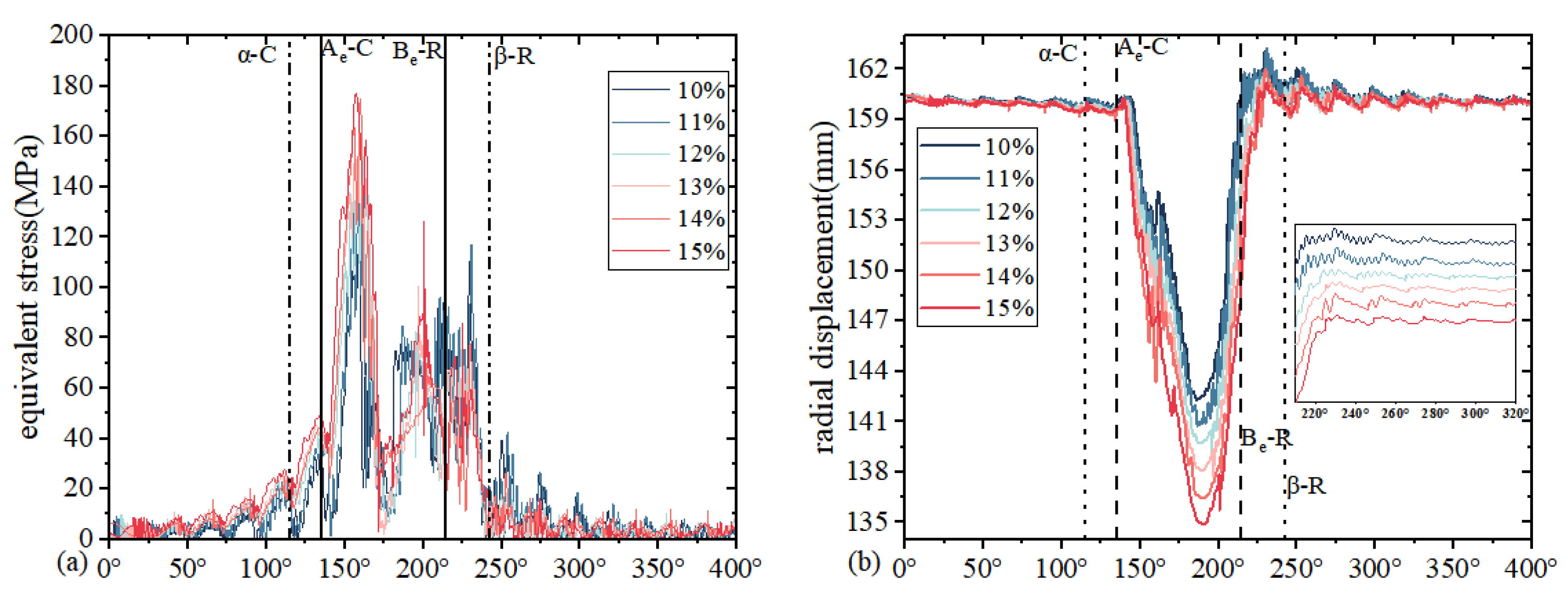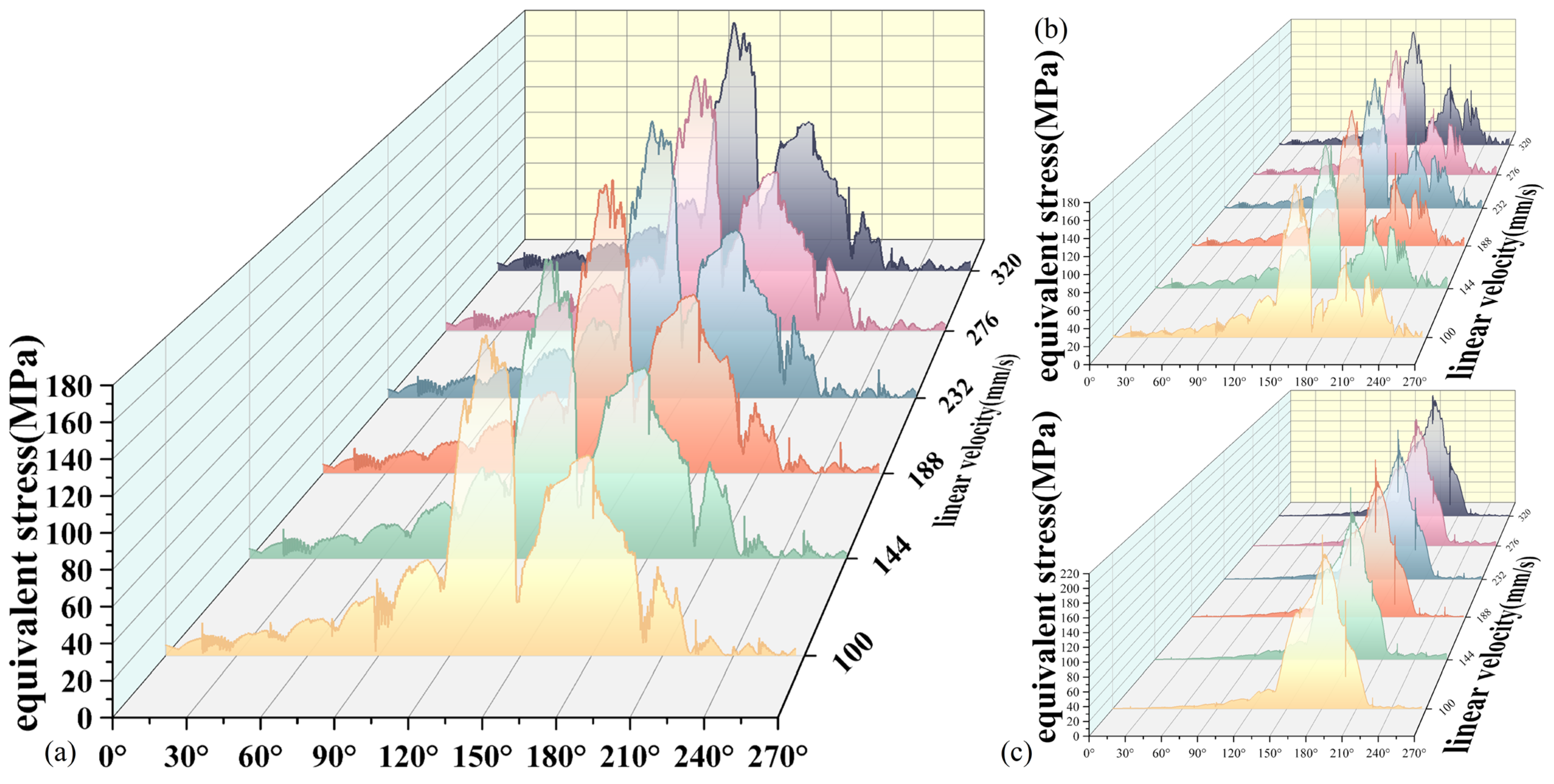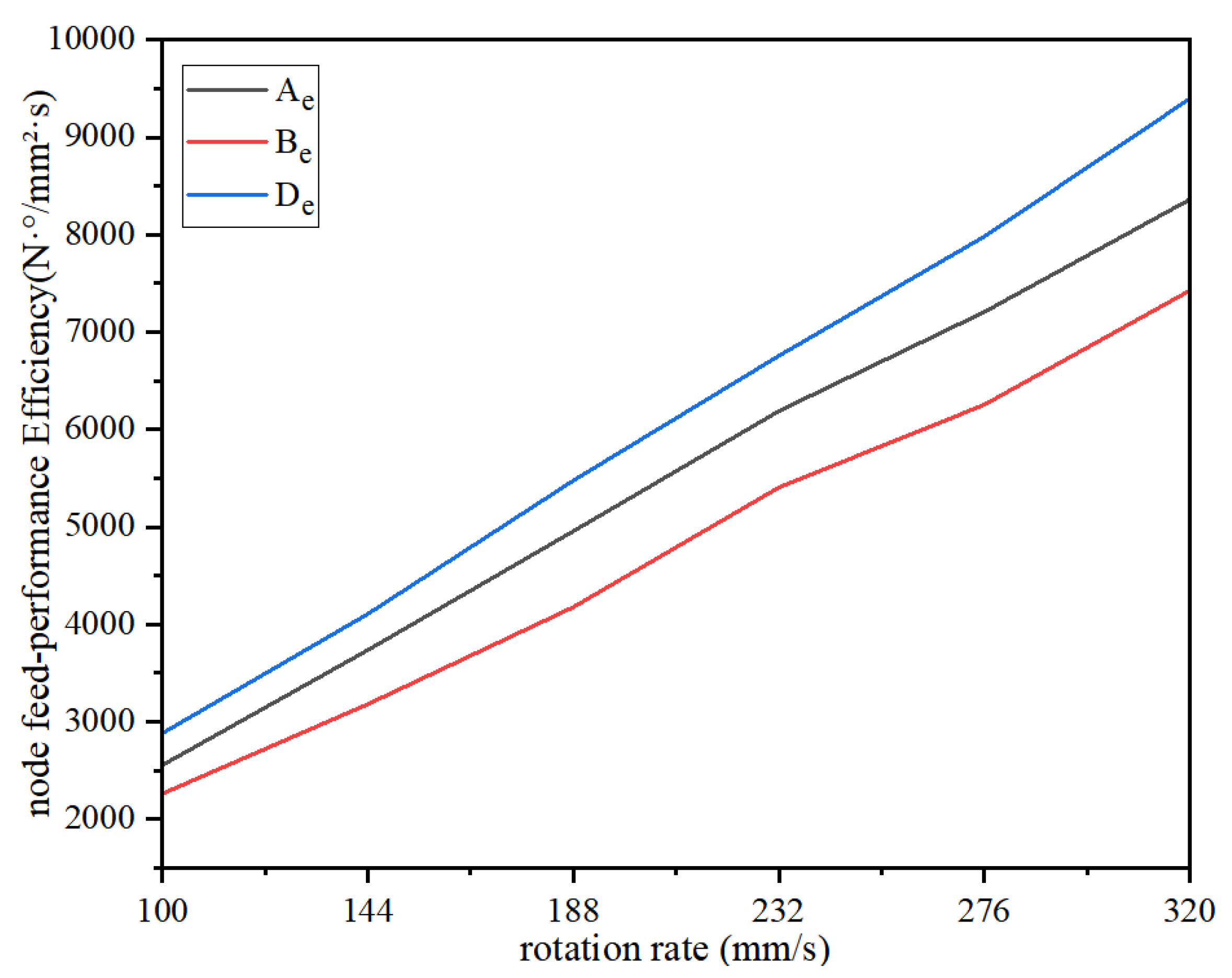The Characteristics of the Deformation of a Feeding Roller with Double V-Wings Honeycomb under Driven Modes with Different Rotation Rates and Axial Compressions
Abstract
1. Introduction
2. Materials and Methods
2.1. Geometry of Feed Roller with DVWH Filling
2.2. Theoretical Basis of Mechanical Properties of DVWH Structures
2.3. FE Model under Driven Modes
3. Numerical Results
3.1. Equivalent Stress of Nodes in Driven Mode
3.2. Radial Displacement of Nodes in Driven Mode
3.3. Deformation Characteristics under Different Compression Rates
3.3.1. Deformation Characteristics of Node Ae
3.3.2. Deformation Characteristics of Node Be
3.3.3. Deformation Characteristics of Node De
3.4. Deformation Characteristics under Different Rotation Rates
4. Discussion
5. Conclusions
- The numerical results indicated that the closer the node was to the loading side, the greater the equivalent stress and radial displacement. In the outermost cell element that made direct contact with the loading plate, the equivalent stress and radial displacement of De node were higher than those of the Ae node and Be node, with De’s peak equivalent stress being 21.9% and 30.6% higher than Ae’s and Be’s. In addition, its significant changes were concentrated in passing through the loading plate on the left and right sides of the cell column; that is, the roller rotates between 115° and 242.6°. In the short time before making contact with the loading plate, the load on the node is the highest.
- Due to the different loading positions, the outermost cells’ deformation characteristics of the roller DVWH structure were different from those of the inner layer. The deformation characteristics of the former were related to the contact state of the loading plate and can be divided into three stages based on the equivalent stress curve characteristics: before contact, during contact, and after contact. The curve of the latter cannot reflect the boundaries of the above states.
- Within the experimental range, the deformation characteristics of nodes were sensitive to compression rate, and the equivalent stress and radial displacement of nodes were positively correlated with compression rate. Taking De nodes as an example, at a 10% compression rate, their maximum changes in radial displacement were 14.93 mm, and the equivalent stress peak was 111.9 MPa. At a 15% compression rate, their maximum changes in radial displacement were 17.2 mm, and the equivalent stress peak was 230.9 MPa. The deformation characteristics of nodes were less sensitive to rotational speed. The radial displacement curves of Ae and De nodes with different rotational speeds only had differentiation in the range of 200°–225°, while the radial displacement curves of Be nodes with different rotational speeds only had differentiation in the range of 137.5°–156°.
- At different compression rates, the radial displacement of nodes had different sensitivity to the degree of compression. Overall, the higher the compression rate, the less sensitive the radial displacement of nodes. At a compression rate of 10%, the radial displacement–compression sensitivities of Ae, Be, and De nodes are 1.294, 1.287, and 0.927, respectively. At a compression rate of 15%, the radial displacement–compression sensitivities of Ae, Be, and De nodes are 1.228, 1.096, and 0.717, respectively.
- The compression rate impacted the deformation characteristics of nodes in the time domain, and an increase in compression rate would cause the moment when the node produces the maximum radial displacement to shift back, with a range of 1° to 3°.
- For the DVWH under the uniform driven mode, the energy absorption characteristics per unit area and per unit time reflected by the index feed performance efficiency (EF) positively correlate with the speed and compression rate. The EF increased the compression rate by 1% at a growth rate of 8.3% to 12.7% while increasing the compression rate by 44 mm/s at a growth rate of about 44%.
Author Contributions
Funding
Institutional Review Board Statement
Informed Consent Statement
Data Availability Statement
Conflicts of Interest
References
- Wang, Y.L. Review on China’s Plantation Development Since the Reform and Opening Up. For. Resour. Manag. 2019, 6–11. [Google Scholar] [CrossRef]
- Pu, S.; Liu, J.H. Development Process and Current Situation of Forestry Harvester Head. Mech. Eng. Autom. 2016, 219–221. [Google Scholar]
- Berendt, F.; de Miguel-Diez, F.; Wallor, E.; Blasko, L.; Cremer, T. Comparison of Different Approaches to Estimate Bark Volume of Industrial Wood at Disc and Log Scale. Sci. Rep. 2021, 11, 15630. [Google Scholar] [CrossRef] [PubMed]
- Nuutinen, Y.; Väätäinen, K.; Asikainen, A.; Prinz, R.; Heinonen, J. Operational Efficiency and Damage to Sawlogs by Feed Rollers of the Harvester Head. Silva Fenn. 2010, 44, 165. [Google Scholar] [CrossRef]
- Strandgard, M.; Walsh, D.; Mitchell, R. Productivity and Cost of Whole-tree Harvesting without Debarking in a Eucalyptus Nitens Plantation in Tasmania, Australia. South. For. J. For. Sci. 2015, 77, 173–178. [Google Scholar] [CrossRef]
- Lu, J.; Yang, T.B.; Di, X.H. Design for feed rollers of harvesting Head Based on Pro/Engineering. For. Eng. 2014, 30, 59–62. [Google Scholar] [CrossRef]
- Qu, Y.; Wang, D. Analyses on the Roller Structure of Equivalent Honeycombs for Forest Harvester under Impact Loading. Compos. Struct. 2021, 262, 113355. [Google Scholar] [CrossRef]
- Wang, Z. Recent Advances in Novel Metallic Honeycomb Structure. Compos. Part B Eng. 2019, 166, 731–741. [Google Scholar] [CrossRef]
- Qi, C.; Jiang, F.; Yang, S. Advanced Honeycomb Designs for Improving Mechanical Properties: A Review. Compos. Part B Eng. 2021, 227, 109393. [Google Scholar] [CrossRef]
- Álvarez Elipe, J.C.; Díaz Lantada, A. Comparative Study of Auxetic Geometries by Means of Computer-Aided Design and Engineering. Smart Mater. Struct. 2012, 21, 105004. [Google Scholar] [CrossRef]
- Yang, H.; Ma, L. Design and Characterization of Axisymmetric Auxetic Metamaterials. Compos. Struct. 2020, 249, 112560. [Google Scholar] [CrossRef]
- Yang, C.; Vora, H.D.; Chang, Y. Behavior of Auxetic Structures under Compression and Impact Forces. Smart Mater. Struct. 2018, 27, 025012. [Google Scholar] [CrossRef]
- Wang, Z.; Lu, Z.; Yao, S.; Zhang, Y.; Hui, D.; Feo, L. Deformation Mode Evolutional Mechanism of Honeycomb Structure When Undergoing a Shallow Inclined Load. Compos. Struct. 2016, 147, 211–219. [Google Scholar] [CrossRef]
- Shen, J.; Ge, J.; Xiao, J.; Liang, J. In-Plane Impact Dynamics of Honeycomb Structure Containing Curved Reentrant Sides with Negative Poisson’s Ratio Effect. Mech. Adv. Mater. Struct. 2022, 29, 1489–1497. [Google Scholar] [CrossRef]
- Shao, Y.; Meng, J.; Ma, G.; Ren, S.; Fang, L.; Cao, X.; Liu, L.; Li, H.; Wu, W.; Xiao, D. Insight into the Negative Poisson’s Ratio Effect of the Gradient Auxetic Reentrant Honeycombs. Compos. Struct. 2021, 274, 114366. [Google Scholar] [CrossRef]
- Li, Z.; Liu, D.; Qian, Y.; Wang, Y.; Wang, T.; Wang, L. Enhanced Strength and Weakened Dynamic Sensitivity of Honeycombs by Parallel Design. Int. J. Mech. Sci. 2019, 151, 672–683. [Google Scholar] [CrossRef]
- Zhang, E.T.; Liu, H.; Ng, B.F. Mechanics of Re-Entrant Anti-Trichiral Honeycombs with Nature-Inspired Gradient Distributions. Int. J. Mech. Sci. 2023, 259, 108597. [Google Scholar] [CrossRef]
- Liu, W.; Zhang, Y.; Guo, Z.; Li, D.; Zhao, S.; Xie, W. Analyzing In-Plane Mechanics of a Novel Honeycomb Structure with Zero Poisson’s Ratio. Thin-Walled Struct. 2023, 192, 111134. [Google Scholar] [CrossRef]
- Zou, Q.L.; Zhou, X.L.; Wang, R.Z.; Liu, H.; Liu, Y. Energy evolution of hexagonal honeycomb under different graded cyclic loading and unloading modes. J. Chongqing Univ. 2023, 46, 45–55. [Google Scholar]
- Zou, Q.; Zhou, X.; Wang, R.; Ning, Y.; Chen, Z.; Kong, F.; Liu, Y. Load-Carrying and Energy-Absorbing Performance of Honeycombs with Different Cross Sections under Cyclic Loading. Mater. Today Commun. 2022, 33, 104582. [Google Scholar] [CrossRef]
- Wu, X.; Yu, H.; Guo, L.; Zhang, L.; Sun, X.; Chai, Z. Experimental and Numerical Investigation of Static and Fatigue Behaviors of Composites Honeycomb Sandwich Structure. Compos. Struct. 2019, 213, 165–172. [Google Scholar] [CrossRef]
- Chen, S.; Tan, X.; Hu, J.; Zhu, S.; Wang, B.; Wang, L.; Jin, Y.; Wu, L. A Novel Gradient Negative Stiffness Honeycomb for Recoverable Energy Absorption. Compos. Part B Eng. 2021, 215, 108745. [Google Scholar] [CrossRef]
- Hao, Z.; Liu, C.; Wang, H.; Simon, J.-W.; Wang, J.; Li, Y. Crushing Behavior of Curved Nomex Honeycombs under Combined Shear-Compression Loads. Int. J. Mech. Sci. 2022, 228, 107480. [Google Scholar] [CrossRef]
- Kelvina Florence, S.J.; Renji, K.; Subramanian, K. Modal Density of Honeycomb Sandwich Composite Cylindrical Shells Considering Transverse Shear Deformation. Int. J. Acoust. Vib. 2018, 23, 11241. [Google Scholar] [CrossRef]
- Ling, B.; Wei, K.; Qu, Z.; Fang, D. Design and Analysis for Large Magnitudes of Programmable Poisson’s Ratio in a Series of Lightweight Cylindrical Metastructures. Int. J. Mech. Sci. 2021, 195, 106220. [Google Scholar] [CrossRef]
- Wang, S.; Wang, H.; Ding, Y.; Yu, F. Crushing Behavior and Deformation Mechanism of Randomly Honeycomb Cylindrical Shell Structure. Thin-Walled Struct. 2020, 151, 106739. [Google Scholar] [CrossRef]
- Gao, Q.; Liao, W.H.; Wang, L. An Analytical Model of Cylindrical Double-Arrowed Honeycomb with Negative Poisson’s Ratio. Int. J. Mech. Sci. 2020, 173, 105400. [Google Scholar] [CrossRef]
- Abayazid, F.F.; Carpanen, D.; Ghajari, M. New Viscoelastic Circular Cell Honeycombs for Controlling Shear and Compressive Responses in Oblique Impacts. Int. J. Mech. Sci. 2022, 222, 107262. [Google Scholar] [CrossRef]
- Jin, X.; Hou, C.; Fan, X.; Sun, Y.; Lv, J.; Lu, C. Investigation on the Static and Dynamic Behaviors of Non-Pneumatic Tires with Honeycomb Spokes. Compos. Struct. 2018, 187, 27–35. [Google Scholar] [CrossRef]
- Suvanjumrat, C.; Rugsaj, R.; Phromjan, J. Comparison of Two Different Surface for Rolling Airless Tire by Finite Element Method. IOP Conf. Ser. Mater. Sci. Eng. 2021, 1137, 012023. [Google Scholar] [CrossRef]
- Zang, L.; Wang, X.; Yan, P.; Zhao, Z. Structural Design and Characteristics of a Non-Pneumatic Tire with Honeycomb Structure. Mech. Adv. Mater. Struct. 2022, 29, 4066–4073. [Google Scholar] [CrossRef]
- Wu, T.; Li, M.; Zhu, X.; Lu, X. Research on Non-Pneumatic Tire with Gradient Anti-Tetrachiral Structures. Mech. Adv. Mater. Struct. 2021, 28, 2351–2359. [Google Scholar] [CrossRef]
- Li, Y.W.; Zang, L.G.; Lv, T. Omtimization design and research of honeycomb porous structure spoke plate non-pneumatic tire. J. Chongqing Univ. Technol. Sci. 2022, 36, 25–33. [Google Scholar]
- Genovese, A.; Garofano, D.; Sakhnevych, A.; Timpone, F.; Farroni, F. Static and Dynamic Analysis of Non-Pneumatic Tires Based on Experimental and Numerical Methods. Appl. Sci. 2021, 11, 11232. [Google Scholar] [CrossRef]
- Ku, L.; Fu, H.; Chen, K.; Zhang, J.; Bi, S.; Zhou, L. Numerical Analysis of Steady-State Mechanical Characteristics of the Flexible Spoke Non-Pneumatic Tire under Multiple Working Conditions. J. Terramechan. 2023, 106, 35–45. [Google Scholar] [CrossRef]
- Ganniari-Papageorgiou, E.; Chatzistergos, P.; Wang, X. The Influence of the Honeycomb Design Parameters on the Mechanical Behavior of Non-Pneumatic Tires. Int. J. Appl. Mech. 2020, 12, 2050024. [Google Scholar] [CrossRef]
- Deng, Y.; Zhao, Y.; Lin, F.; Xiao, Z.; Zhu, M.; Li, H. Simulation of Steady-State Rolling Non-Pneumatic Mechanical Elastic Wheel Using Finite Element Method. Simul. Model. Pract. Theory 2018, 85, 60–79. [Google Scholar] [CrossRef]
- Wang, D.; Wang, D.; Liu, J.H.; Huang, Q.Q. Mechanics Characteristics of Feeding Roller Filled with Honeycomb Structure. J. Northeast. For. Univ. 2020, 48, 93–99+104. [Google Scholar] [CrossRef]
- Zhu, X.C.; Wang, D.; Liu, J.H.; Huang, Q.Q. Coupling relationship between structure parameters of double-V-wings honeycomb whit negative Poisson’s ratio and log contact area. J. Huazhong Agric. Univ. 2021, 40, 253–260. [Google Scholar] [CrossRef]
- Zhang, G.Q.; Wang, D.; Qu, Y.F.; Liu, J.H. Radial compression response of honeycomb rollers with multi dense degrees for forest harvester. J. Beijing For. Univ. 2022, 44, 135–145. [Google Scholar]
- Larsen, U.D.; Signund, O.; Bouwsta, S. Design and Fabrication of Compliant Micromechanisms and Structures with Negative Poisson’s Ratio. J. Microelectromechanical Syst. 1997, 6, 99–106. [Google Scholar] [CrossRef]
- Qiao, J.X.; Chen, C.Q. Impact Resistance of Uniform and Functionally Graded Auxetic Double Arrowhead Honeycombs. Int. J. Impact Eng. 2015, 83, 47–58. [Google Scholar] [CrossRef]
- Ruan, D.; Lu, G.; Wang, B.; Yu, T.X. In-Plane Dynamic Crushing of Honeycombs—A Finite Element Study. Int. J. Impact Eng. 2003, 28, 161–182. [Google Scholar] [CrossRef]
- Qu, Y.F.; Wang, D.; Zhu, X.C. Analyses on key techniques and application performance of honeycomb feeding roller for forest combine harvester. J. Anhui Agric. Univ. 2021, 496–503. [Google Scholar] [CrossRef]
- Zhang, J.; Lu, G.; You, Z. Large Deformation and Energy Absorption of Additively Manufactured Auxetic Materials and Structures: A Review. Compos. Part B Eng. 2020, 201, 108340. [Google Scholar] [CrossRef]

















| R/mm | R0/mm | t/mm | θ1 | θ2 | r/mm | L | T/mm |
|---|---|---|---|---|---|---|---|
| 160.1 | 68 | 3.5 | 30° | 75° | 20.3 | 3 | 50 |
| Parameter | Value | |||||
|---|---|---|---|---|---|---|
| 10% | 11% | 12% | 13% | 14% | 15% | |
| (mm/s) | 100 | 144 | 188 | 232 | 276 | 320 |
Disclaimer/Publisher’s Note: The statements, opinions and data contained in all publications are solely those of the individual author(s) and contributor(s) and not of MDPI and/or the editor(s). MDPI and/or the editor(s) disclaim responsibility for any injury to people or property resulting from any ideas, methods, instructions or products referred to in the content. |
© 2024 by the authors. Licensee MDPI, Basel, Switzerland. This article is an open access article distributed under the terms and conditions of the Creative Commons Attribution (CC BY) license (https://creativecommons.org/licenses/by/4.0/).
Share and Cite
Zhou, W.; Wang, D. The Characteristics of the Deformation of a Feeding Roller with Double V-Wings Honeycomb under Driven Modes with Different Rotation Rates and Axial Compressions. Appl. Sci. 2024, 14, 2082. https://doi.org/10.3390/app14052082
Zhou W, Wang D. The Characteristics of the Deformation of a Feeding Roller with Double V-Wings Honeycomb under Driven Modes with Different Rotation Rates and Axial Compressions. Applied Sciences. 2024; 14(5):2082. https://doi.org/10.3390/app14052082
Chicago/Turabian StyleZhou, Wenhui, and Dian Wang. 2024. "The Characteristics of the Deformation of a Feeding Roller with Double V-Wings Honeycomb under Driven Modes with Different Rotation Rates and Axial Compressions" Applied Sciences 14, no. 5: 2082. https://doi.org/10.3390/app14052082
APA StyleZhou, W., & Wang, D. (2024). The Characteristics of the Deformation of a Feeding Roller with Double V-Wings Honeycomb under Driven Modes with Different Rotation Rates and Axial Compressions. Applied Sciences, 14(5), 2082. https://doi.org/10.3390/app14052082






